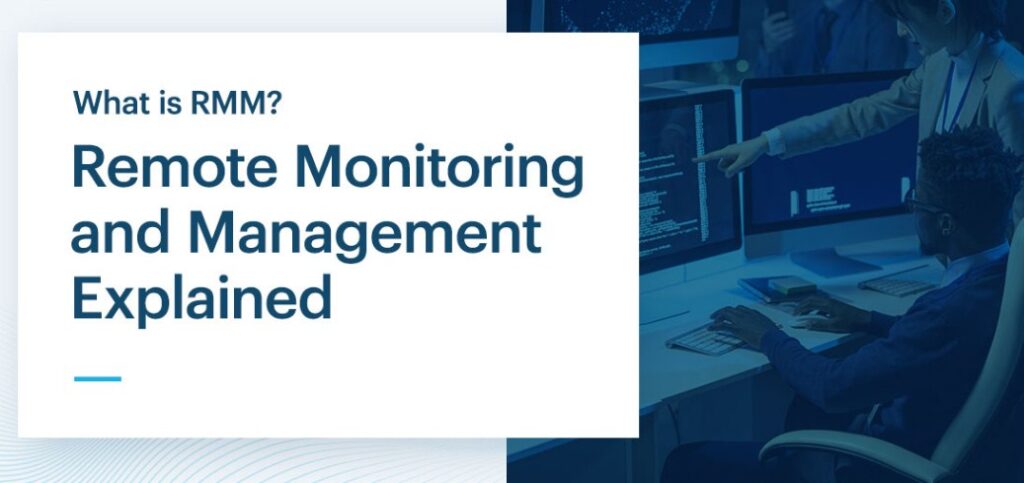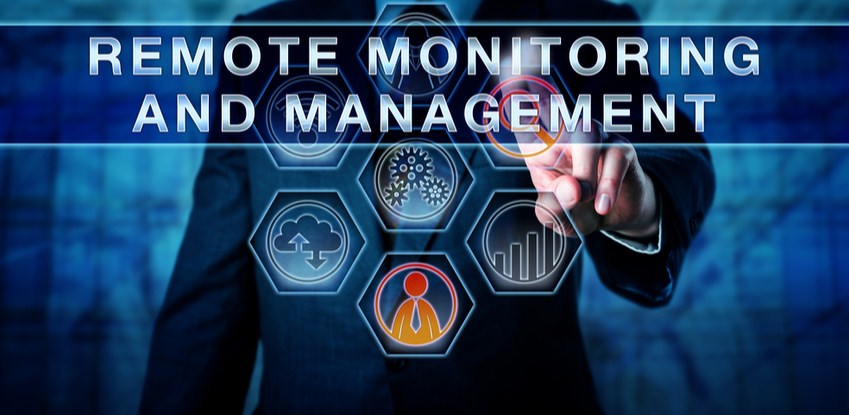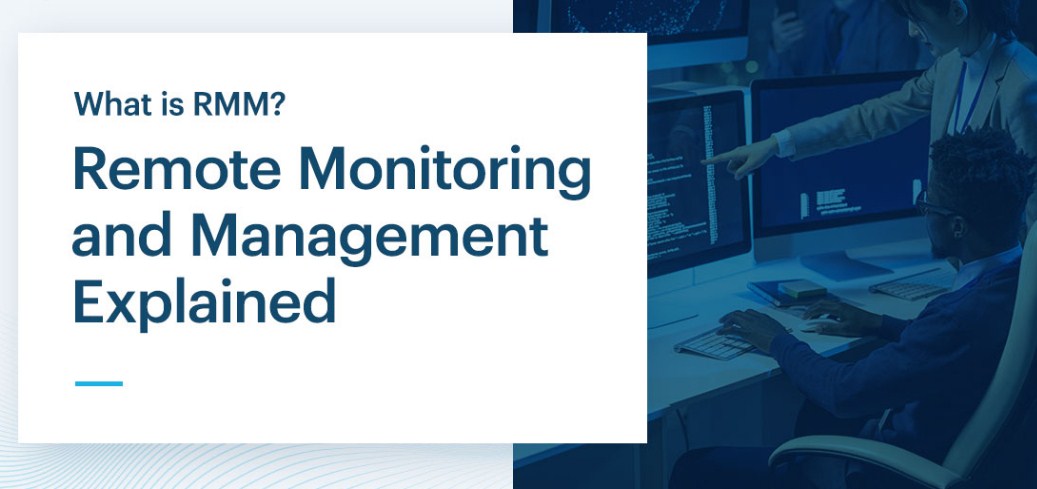RMM Meaning Explained – RMM stands for Remote Monitoring and Management, a critical technology used by businesses, especially in the IT industry. It enables professionals to remotely manage, monitor, and maintain various devices and IT systems. This practice allows businesses to ensure smooth operations and reduce the need for on-site support.

In this article, we’ll break down the full meaning of RMM, its benefits, and the top products related to this technology. If you’re looking to explore how RMM can enhance your operations or help in managing IT assets more efficiently, this guide will provide you with all the information you need.
Understanding RMM: How It Works and Why It Matters
RMM software empowers businesses to remotely manage and monitor devices such as servers, workstations, networks, and even mobile devices. Typically used by Managed Service Providers (MSPs), it can also be utilized by in-house IT teams. The software collects real-time data, such as device health metrics, network traffic, and software usage, which can then be analyzed to ensure everything is running smoothly.
Here’s how it works:
- Monitoring: RMM tools allow IT professionals to track the health and performance of devices, software, and networks remotely. They get real-time alerts when something goes wrong.
- Management: Technicians can perform tasks such as software updates, patches, or even full system optimizations, all without being physically present.
- Automation: RMM tools often come with automation features, which allow repetitive tasks to be scheduled, saving time for IT staff.
Why is RMM so important?
- Cost Efficiency: RMM reduces the need for on-site visits, lowering operational costs.
- Proactive Management: Detect and resolve issues before they impact productivity.
- Security: Keep systems up-to-date with the latest security patches and updates, preventing potential cyber threats.
The Key Benefits of RMM
1. Improved Efficiency and Productivity
Using RMM tools, IT teams can quickly diagnose problems and apply fixes remotely, which reduces downtime and enhances productivity. This can be especially beneficial for organizations that rely on remote teams.
2. Reduced Operational Costs
Without RMM, businesses may need to employ additional on-site support staff. With RMM, much of the work can be done remotely, saving time, money, and resources.
3. Better Security and Compliance
RMM tools automate security patches and updates. This ensures that all systems are running with the latest security measures, reducing the risk of cyberattacks. Moreover, RMM systems often have built-in compliance features to adhere to industry regulations.
4. Scalability
Whether your organization has 10 devices or 1000 devices, RMM software can scale up or down to accommodate your needs. This flexibility is one of the reasons why it’s so popular with both small businesses and large enterprises.
5. 24/7 Monitoring and Support
RMM solutions ensure that devices are continuously monitored, even outside regular working hours. This 24/7 coverage means that any issues can be detected and dealt with at any time, improving uptime and reducing the risk of system failures.
Top RMM Products You Need to Know About
There are numerous RMM tools available today, each offering a variety of features tailored to specific needs. Here’s a breakdown of the top 5 RMM tools:

1. Datto RMM
Overview: Datto RMM is an all-in-one solution that provides remote monitoring, management, and backup solutions. It is widely known for its easy-to-use interface and reliability, making it ideal for MSPs.
Use Case: Ideal for Managed Service Providers looking to support multiple clients at once.
Pros:
- Seamless backup and disaster recovery integration.
- Strong security features.
- Easy integration with existing systems.
Cons:
- High price point for small businesses.
- Learning curve for beginners.
Price: Contact for pricing (depends on the scale of the business).
Features:
- Real-time system health monitoring.
- Automated patch management.
- Integrated backup and disaster recovery tools.
2. ConnectWise RMM
Overview: ConnectWise offers a powerful RMM platform that helps IT professionals manage endpoints, networks, and systems remotely. It provides robust automation and analytics capabilities.
Use Case: Best suited for MSPs and businesses with diverse IT environments.
Pros:
- Automation and remote troubleshooting.
- Centralized dashboard for all systems.
- Integrates with other IT management tools.
Cons:
- Can be overwhelming for smaller companies.
- Higher pricing structure.
Price: Pricing starts at $40 per month per device.
Features:
- Real-time monitoring.
- Automation features for routine tasks.
- Reporting and analytics tools.
3. SolarWinds RMM
Overview: SolarWinds is a widely used RMM tool that is known for its reliability and scalability. It’s suitable for IT professionals who manage complex IT infrastructures.
Use Case: Perfect for companies with large networks and multiple endpoints.
Pros:
- Comprehensive monitoring and management tools.
- Scalable to suit businesses of any size.
- Excellent customer support.
Cons:
- Interface can be complex for new users.
- Some features may require additional add-ons.
Price: Starting at $100 per month (for 10 devices).
Features:
- Remote control and monitoring of devices.
- Customizable reporting tools.
- Patch management and security tools.
4. Atera RMM
Overview: Atera offers an intuitive RMM solution that’s known for being user-friendly and affordable. It’s designed for MSPs but is also great for small to medium businesses.
Use Case: Best for small to mid-sized businesses needing a straightforward and affordable RMM solution.
Pros:
- Pay-as-you-go pricing model (per technician).
- Easy-to-use interface.
- Integrated billing and reporting tools.
Cons:
- Limited scalability for large enterprises.
- Fewer advanced features compared to other platforms.
Price: Starts at $79 per technician per month.
Features:
- Device monitoring and management.
- Patch management and software deployment.
- Reporting and analytics.
5. Kaseya VSA
Overview: Kaseya VSA is a popular RMM solution offering comprehensive monitoring and management capabilities for MSPs and enterprises. It’s designed for advanced use cases with high-end features.
Use Case: Ideal for large enterprises or MSPs who require extensive customization and scalability.
Pros:
- High-level customization options.
- Strong security features.
- Excellent for large businesses.
Cons:
- Expensive for small businesses.
- Somewhat complex for new users.
Price: Contact for pricing (depends on the number of devices).
Features:
- Endpoint management.
- Real-time system monitoring.
- Security patch management.
How RMM Products Solve Common IT Challenges
Challenge 1: Downtime and Device Failures
- Solution: With RMM tools, IT teams can monitor the health of systems in real time, enabling them to address issues proactively before they cause downtime.
Challenge 2: Security Vulnerabilities
- Solution: RMM solutions regularly update software and apply security patches automatically, keeping systems secure and compliant.
Challenge 3: Inefficient Resource Allocation
- Solution: RMM tools automate repetitive tasks, freeing up resources for more critical tasks.
Challenge 4: Difficulty Scaling Operations
- Solution: Many RMM tools, like Datto and ConnectWise, offer scalable solutions that grow as your business does, making them perfect for expanding companies.
Where and How to Buy RMM Products
If you’re interested in purchasing one of these RMM solutions, here’s how you can do it:
- Visit the product’s official website: For each RMM solution listed above, visit their official website (linked in the product name) to view pricing and purchase details.
- Contact sales for pricing: Most RMM tools offer customized pricing based on your needs (number of devices, features, etc.).
- Request a demo: Many platforms, like Atera and ConnectWise, offer free trials or demos to help you understand their features before committing.
FAQs
1. What is the primary function of RMM software?
- RMM software is used to remotely monitor and manage IT systems, including devices, servers, and networks, from a central location.
2. Can RMM be used for small businesses?
- Yes, RMM solutions are scalable and can be beneficial for both small businesses and large enterprises.
3. What’s the difference between RMM and traditional IT management?
- Traditional IT management requires on-site staff to perform maintenance, while RMM tools allow for remote monitoring, management, and automation of tasks.
4. Are RMM solutions expensive?
- Pricing varies by provider. There are affordable options for small businesses and more advanced solutions for large enterprises.
5. How can I choose the best RMM tool for my business?
- Consider your business’s size, budget, and specific needs (security, automation, scalability) when choosing the best RMM solution.
By understanding RMM and its offerings, you can effectively manage and monitor your IT systems remotely, saving time, money, and resources. Be sure to evaluate each tool and choose the one that best fits your company’s needs!
Read More >>>
- Cloud ERP Manufacturing: The Ultimate Guide to Streamline Your Production
- Hybrid ERP: A Comprehensive Guide to Revolutionizing Business Management
